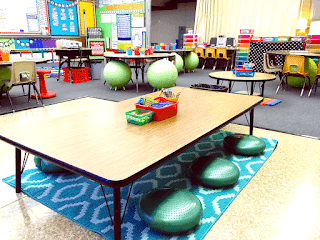Flexible Learning Starts With Flexible Classroom Spaces
The latest craze with my
New Hampshire high school teachers is to supplement, or in some cases replace
their institutional, inflexible classroom furniture with more student-friendly
options. In a school with a very tiny furniture budget, my staff has accomplished
this task by soliciting donations, applying for grants, and in some cases,
building their own furniture. A walk through the few re-imagined spaces that we
have completed thus far is reminiscent of a trip through a trendy Ikea
showroom. Many of the individual student desks have been replaced with tables
on wheels that can be reconfigured as needed by students, comfortable reading
chairs and lounges, and even carpeted corners with bean bags and pillows. Two of
my ninth grade math teachers actually purchased white board paint at the local
hardware store to coat their tabletops so that students could work through
their math problems right at their collaborative tables with colorful dry-erase
markers. The local Chief of Police helped them secure a donation of fancy
executive leather chairs for student use from a nearby corporate office that
was looking to downsize. After a year of use, the students in these classes
seemed to be able to attribute increased engagement and excitement for math to
their flexible environment. Although these findings are mostly subjective and anecdotal, research is now starting to surface to back the claim that flexible
learning starts with flexible classroom spaces.
According to this recent Edutopia article, the
research on flexible classrooms is scarce, but promising. As the article
explained, the scarcity is due in large part to the fact that “flexible
classrooms are complex, living systems. One flexible space looks nothing like
the next, and often dozens of children and one or more teachers operate within
them, pushing and pulling furniture into novel configurations, dimming or
turning up lights, and otherwise reshuffling things to suit an almost infinite
variety of personal preferences.”
The United Kingdom’s University of Salford 2015 study measured the impact that flexible classrooms
can have on learning. To complete this, researchers visited 153 classrooms
in 27 schools across the country. These schools ranged in size from small,
remote village schools to large suburban buildings in or near cities such as
London. In all, nearly 4,000 children between the ages of 5 to 11 were included.
Researchers
considered three dimensions of classroom design: naturalness (light and
temperature), stimulation (color, visual complexity), and individualization
(flexibility, student ownership). It was observed that by optimizing these
dimensions, academic performance in reading, writing, and mathematics improved by
16 percent. What is more astounding is that the dimension of individualization,
particularly student choice and voice, accounted for a quarter of that
improvement. Other surprises came from the effect of learning on math. In the
study, 73 percent of student achievement was attributed back to classroom
design that was traced back to flexibility and student ownership. Researchers
theorized that thus may be due to the ability of a flexible classroom to better
address anxiety provoked by academic subjects such as math. In other words,
students perform better in familiar, comfortable environments.
Edutopia’s
article reached this conclusion: “Classroom flexibility, isolated from other
measured factors, appears to be roughly as important as air quality, light, or
temperature in boosting academic outcomes.”
The
trend to move to flexible classroom spaces is not limited to K-12 schooling. This recent University of Michigan article discussed how flexible classrooms are
positively impacting both teaching and
learning at the University. The school spent a great deal of its resources to
provide flexible options to students in various classrooms across campus in an
effort to
encourage more instructors to use more active learning. According to the
article, here is what has already been observed:
- Faculty members made creative use the monitors throughout the room to show slides of the class material, have students work together on a Google Document, and collectively work through a problem.
- · Faculty felt the monitors throughout the room helped students focus on the task at hand and minimized distractions.
- · Faculty noted that in traditional lecture-based classrooms students tended to sit anywhere during class sessions with lecture, but in the flexible spaces gravitated toward their teammates. This was helpful in getting students to know each other better and build effective teams.
- · Faculty developed new activities that were specifically suited for the flexible classroom.
For many educators, it is an easy
“sell” to suggest that students respond positively to classrooms that promote
comfort, flexibility, and collaboration. For many school leaders, myself
included, school budgets simply can’t support the complete replacement of
furniture for each classroom. Perhaps studies such as the ones mentioned in
this article will help more schools justify the need for such projects in the
coming years.
This article was written originally for MultiBriefs Education.




Comments
Post a Comment